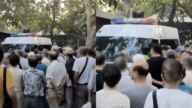【新唐人2011年11月3日讯】北京连日来大雾笼罩,空气污染情况恶化,美国驻华大使馆连续两天监测的结果显示,北京空气污染已经达到了“危险”水准,近一周来民众因呼吸道不适看急诊的人数剧增,医生提醒尽量不要出门,以免影响健康。不过,北京环保局测得的数据则显示属于轻微污染,民众讷闷那个数据准确吗?
北京三面环山,连日来的大雾一直无法散去,据120急救中心发布的消息,最近因呼吸道不适被送进医院的患者人数比上周多了13%,因气喘、气管炎和肺炎看急诊的病人也增加了30%。网民形容北京的大雾为“毒气”,空气污染已经严重影响民众的健康。官员不以为然的态度,民众只好自行监测空气品质。
美国驻华大使馆两年前开始在北京的使馆区内,设立了空气监测站,定时将最新资料上传到互连网上。10月31号和11月1号连续二天测到空气污染指数是300到400,有时甚至达到测量的极限值500。这个数据获得了中国环保组织的监测证实。
而这样的数据显示,北京的24小时空气污染情况已达到“危险”水准,是六个级别中最严重的一个,代表所有人的健康都会受到影响,而且可能出现一些引发疾病的情况。
不过,北京市环保部门发布的空气污染指数停留在150到170之间的“轻度污染”,北京市环保局11月1号公布北京市10月份空气品质资料显示,有19天空气品质达到优良水准,另外12天则为轻微或轻度污染,环境监管部门试图淡化事态的严重性。
北京市民彭定鼎说,因为两个不一样的数据,不知道该相信谁,所以已经有网友在自行监测了。
彭定鼎:“大家公布的二个数据如果不一致的话,请网友自行去检查。我相信网友甚于相信美国大使馆,我相信美国大使馆更甚于相信中国政府。”
国立台湾大学大气科学系教授徐光蓉表示,PM2.5的粒子大部分是空气污染物气体凝结出来的,大部分会有致癌物或是重金属,这些东西是属于人为的污染。
徐光蓉:“美国的这个方面我比较相信他,它的数据我认为他不会去故意的夸大,他为什么会去设一个在自己大使馆里面,我想他比较担心那个空气品质对美国侨民的影响,所以他想了解一下。所以我认为美国驻中国大使馆的数据应该是比较正确的。”
据了解,美国驻华大使馆所监测的直径在2.5微米以下、也称PM2.5的悬浮颗粒,对健康的危害,近年已获学术界认定。而中国的空气品质报告监测的是直径在10微米以下的可吸入颗粒物。就是PM10。
徐光蓉:“北京PM10的话,它是立径小于10个微米,可是我们的呼吸道大概平常10个微米以下才会进去嘛,那PM2.5它基本上就会到我们呼吸道的很尖端,也就说它可能在我们的肺套去跟那个血液里面交换空气,所以PM2.5跟人体是比较更有直接影响。”
由于目前中国东北部依然弥漫着大雾,因此空气中的污染物恐怕不容易散去。连日来的大雾,已对华北地区的交通造成较大影响,北京首都国际机场也因此取消了160多趟航班。
新唐人记者周玉林、李庭、孙宁采访报导。
China’s “Poisonous Air" Hits “Danger" Level
Recently, Beijing has been shrouded in smog
with fast deteriorating air quality.
According to results from the U.S. embassy in China,
for two continuous days the air pollution in Beijing has reached the “danger" level.
The number of people sent to the emergency room
due to respiratory discomfort has increased substantially.
Doctors remind people to avoid going outside
because of the bad effect this causes to health.
However, results from Beijing Environmental Protection
Agency (BEPA) show that the air is only slightly polluted.
Many wonder how accurate these results are.
Beijing is surrounded by mountains from three directions,
but of late, the smog has been unable to disperse.
According to information from 120 Emergency Center,
the number of patients sent to hospitals for respiratory discomfort has increased by 13% since last week.
The number of patients sent directly to the emergency rooms
because of asthma, bronchitis and pneumonia is 30% higher.
Netizens describe Beijing’s smog as “poisonous air" and
the air pollution has affected people’s health severely.
Because of the government’s unresponsive attitude,
people can only monitor air quality by themselves.
Two years ago, the U.S. embassy in China set up two air-
monitoring stations in the Beijing embassy district.
They upload the latest information straight to the internet.
The air pollution index for Oct. 31 and Nov. 1 are 300 and 400 respectively.
Sometimes the index reaches the max level, which is 500.
This data has been confirmed by China’s environmental protection organizations.
The data indicates Beijing’s 24-hour air pollution has reached
the level of “Danger,” the most severe of the six levels.
This level means all people’s health would be affected
and could possibly trigger large-scale diseases.
However, the air pollution index from BEPA stayed
between 150 and 170, which means just light pollution.
On Nov. 1, BEPA published the data of the air quality for Oct.
It is said that over 19 days the air condition was quite good, and over the other 12 days the air was lightly polluted.
The environmental regulatory authorities tried to diminish
the seriousness of this issue.
A citizen of Beijing, Peng Dingding, said that because there
were two different data, he didn’t know which to believe.
Thus, now some netizens started to monitor
the air condition for themselves.
Peng Dingding:"Please check the air condition for
yourselves if the two published data are not the same.
I believe netizens more than the U.S. embassy, and I believe
the U.S. embassy more than the Chinese government."
Professor Xu Guangrong is from the Department
of Atmospheric Sciences, Taiwan National University.
He said that PM2.5 particles are mainly the gas condensation
of air pollutants which contain heavy metals, or carcinogens, due to man-made pollution.
Prof. Xu Guangrong: “I believe the U.S. in this aspect.
I do not think they will deliberately exaggerate the data.
I think they put air monitoring stations in their embassy
due to concerns over the pollution effects on U.S. nationals.
So they want to know that. I think the data
from the U.S. embassy in China is more accurate."
The particles which are 2.5 microns in diameter,
are also known as PM2.5 suspended particles.
Monitored by the U.S. embassy, they are considered a health
hazard, identified as such by academia in recent years.
But China’s air quality report monitors respiratory particles
matter with a diameter of 10 microns, which is PM10.
Xu Guangrong: “Beijing monitors PM10,
which are particles with 10 microns in diameter.
But the human respiratory track can only handle suspended
particles with a diameter of less than 10 microns.
Then the PM2.5 could basically reach the very end
of our respiratory track.
This means PM2.5 could replace the air in blood and lungs.
So the PM2.5 has more direct impact on the human body."
Because now the northeastern part of China is still shrouded
in smog, the pollutants in the air may not dissipate easily.
The smog in the continuous few days has greatly affected
traffic in the northern part of China.
Due to this, Beijing International Airport
has cancelled more than 160 flights.
NTD reporters Zhou Yulin, Li Ting and Sun Ning.





























